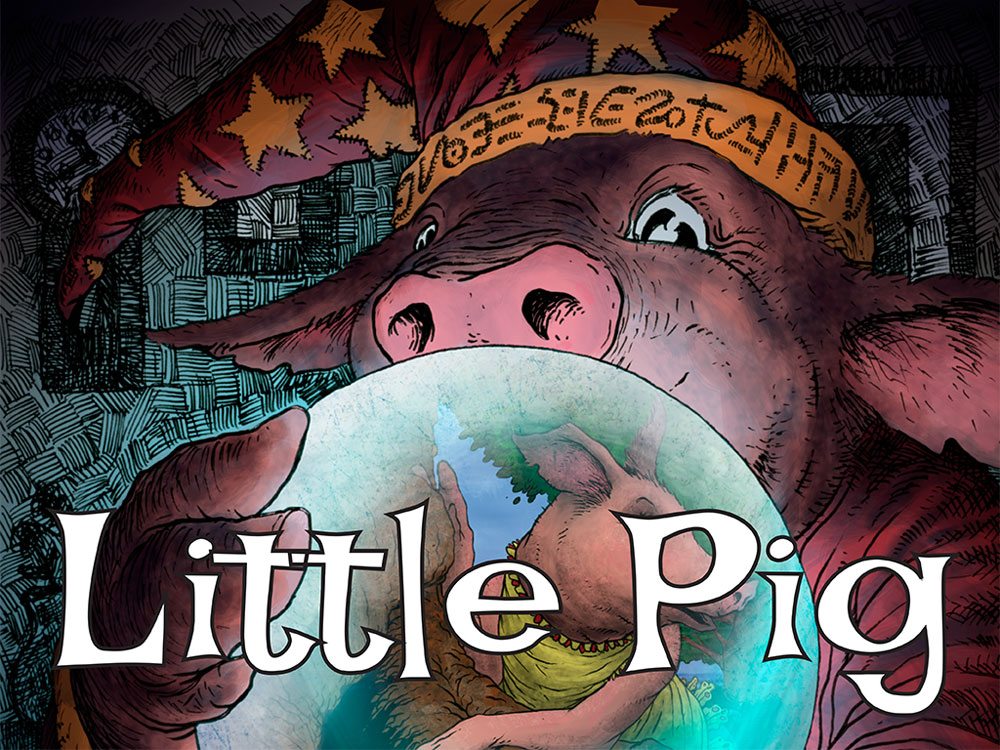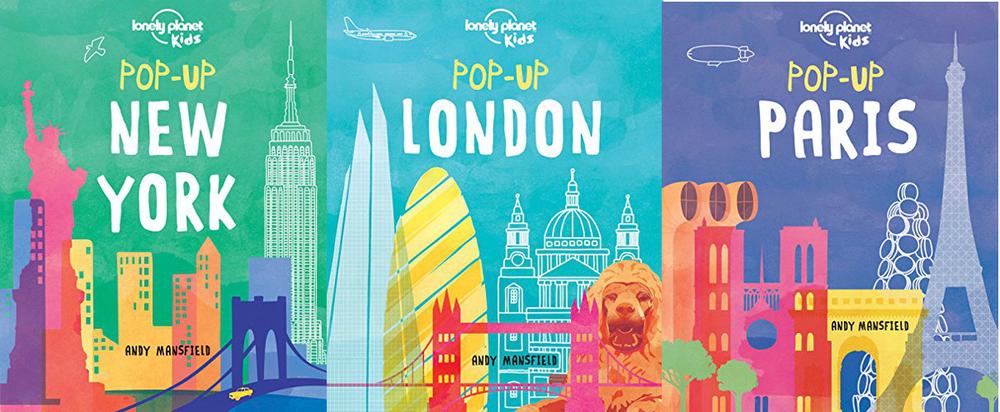You know the story of the three little pigs and the big bad wolf, but what you may not know is that they’re competing contractors. Each one is trying to get a few houses built before the others … and of course the Big Bad Wolf is happy to bring his special brand of interference into the mix.
At a glance: Little Pig is a game by Tim Eisner for 2 to 3 players, ages 13 and up, and takes about 30-45 minutes to play. It’s currently on Kickstarter, with a pledge level of $25 for a copy of the game. I think the game would probably work for kids as young as 8 to 10–the rules aren’t too complex, but it’s mostly about how well you can read the other players.
New to Kickstarter? Read our crowdfunding primer.

Components
- 1 Game Board
- 3 Player Boards
- 48 Single Resource Tokens – 20 Straw, 16 Wood, 12 Brick
- 24 Multi-Resource Tokens (8 each in straw, wood, brick)
- 9 Gather Cards
- 20 Guess Cards
- 9 Friend Cards
- 1 Starting Player Token
- 3 Pig Tokens
- 3 Wolf Tokens
- 36 House Sections (12 each in straw, wood, brick)
My review was based on a demo prototype, so the components are subject to change based on stretch goals, and the prototype was not final quality.
Some of the illustrations were complete and I’ve seen some of the finished artwork for the cards, and it looks great. The illustrations, by Jason Reynolds and Ryan Swisher, have a fairy tale storybook feel to them that really fits the theme well.
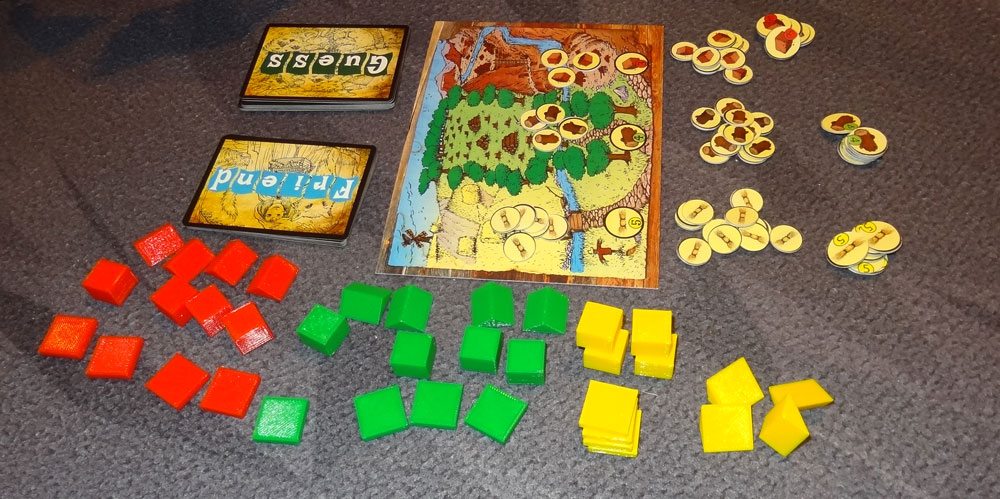
How to Play
The object of the game is to be first to build three houses (of any material).
Each player gets a player board, three Gather cards, and a pig token. The two decks of cards are shuffled separately, and the game board is placed in the center of the table, along with all of the resource tokens. One player gets the Starting Player token.
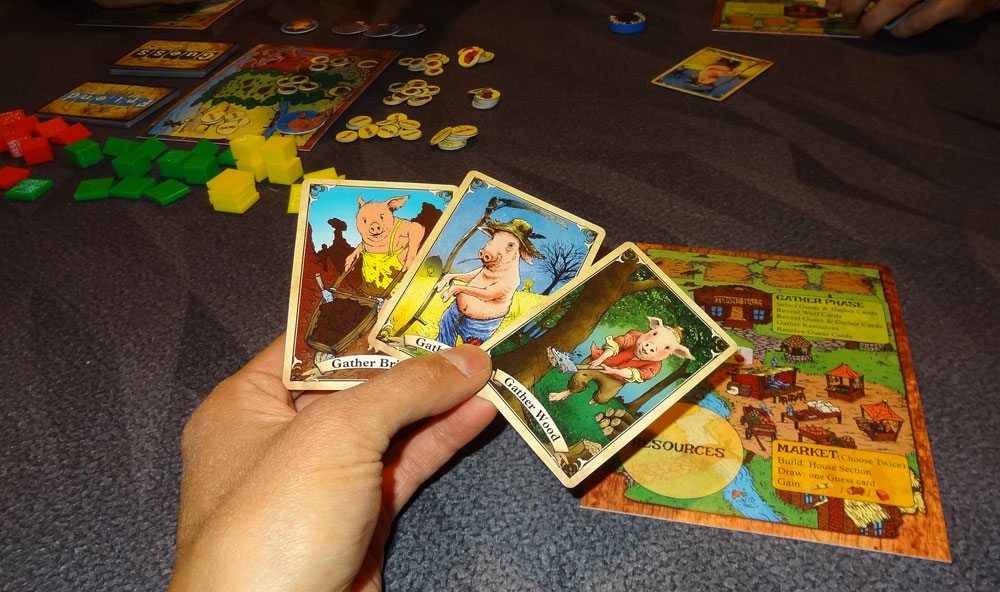
To start each round, you’ll add resources to the game board (5 straw, 4 wood, 3 brick). Then, each player will secretly choose one of their three Gather cards (Straw, Wood, or Brick) and up to 1 Guess card. Once everyone has chosen, the Starting Player first asks if there are any Wolves (a specific type of Guess card). Once those are resolved, the Gather cards are revealed and pig tokens are placed in the corresponding locations on the board. Players divide up the resources available at the locations equally among the pigs present. If you’re the only one at a location, you get all of the resources. If there is a remainder, it stays on the board for the next round.

Then, Guess cards are resolved. These will provide a bonus of some sort if you correctly predicted where other players were going to gather. The Wolf is a special Guess card that lets you clear out all resources from a location before the Gather cards are revealed. Others may give you bonuses for being with other pigs, being by yourself, and so forth.
Once this phase is over, each player in turn order gets 2 market actions. You can choose any of the following (including repeating an action):
- Build 1 house section (costs: 2 for foundation, 4 for walls, 6 for roof)
- Draw a Guess card
- Take 1 resource of your choice
When building houses, you must build from the bottom up, and you can’t mix materials in a single house. You may start multiple buildings, but you may not start another house if you have an unfinished house of that material.
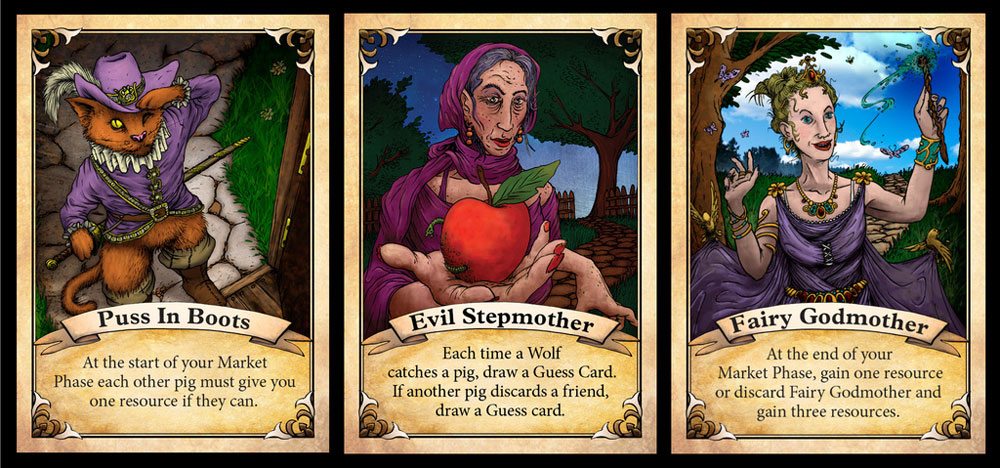
Every time you build walls, you get a Friend bonus. Draw the top Friend of the deck. Either keep it (and discard your old Friend, if any) or else give the new Friend to another player, forcing them to discard their old Friend. Friends give you various benefits during the game.
If you’re the first to complete a house of a particular building material, you get a bonus of 1 of each resource from the supply.
After everyone has taken their 2 market actions, the Starting Player token is passed, and the next round begins.
The game ends at the end of a round when any players have finished at least 3 houses. If there’s a tie for number of houses (because more than one player reached 3 in the same round), then the quality of the houses breaks ties.
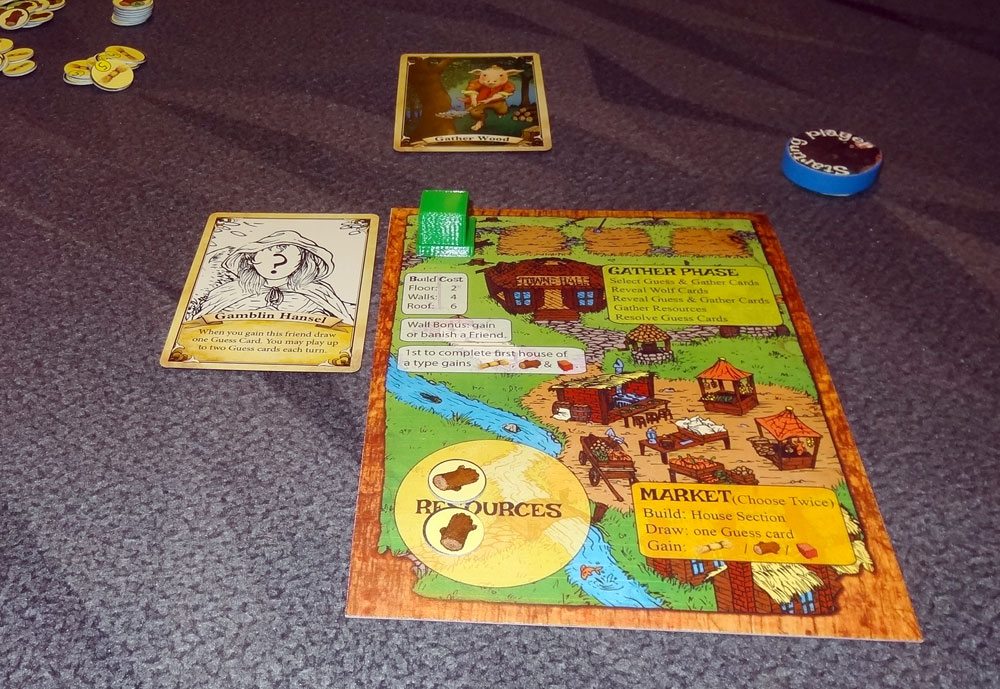
Note: the 2-player version has some slight variations in the rules–it introduces the Donkey, which is a random draw that will clear out half of the resources in one location, but doesn’t count as a Pig card for Guess cards. There’s also a stretch goal for a 4-player version, which introduces the City as a new gathering location. The City gains one of each type of resource each round, and there are some other slight tweaks to the rules for 4 players.
The Verdict
At first glance, Little Pig looks like a resource management game: you collect resources and use them to build houses. That’s true, but only party. The key mechanic is the guessing and gathering–figuring out where other players are headed, and using that knowledge to your own advantage. At first, it’s just sort of a gamble: do you go for Straw, because it’s more plentiful and it’ll be easier to gather? Or do you go for the Brick, because there’s not as much and maybe nobody will want to go there? Of course, if multiple pigs show up in the Brickyard, then that’s doubly bad.
Once you start collecting Guess cards, however, you have even more of an incentive to figure out what the other players want. Use a Wolf to wipe out resources from a location, or play your Secret Stash to guarantee a few resources if you think somebody will send a Wolf to you. Play Boss Hog when you’re going to the same place as somebody else so that you can steal some of their market actions.
Of course, there is still some resource management. You’ll have to work out the trade-off between building cheap Straw Houses or building Brick Houses that can’t be blown down by the Big Bad Wolf. Also, since you get a bonus for finishing a house type that nobody else has built yet, players often tend to specialize so they don’t have to race for a particular resource.
Compared to Weird City Games’ first design, March of the Ants, Little Pig was quite simpler and I think will work for a broader audience. March of the Ants is great, but it’s pretty complex and there are a lot of moving parts. Little Pig is more approachable, both in theme and complexity. However, that may mean that it won’t scratch the heavy strategy itch for some gamers.
The Friends provide an interesting tweak. Each one has different abilities, and since you only get Friends by building walls (or when somebody else builds a wall and sends you a Friend), there will be a limited number that come into play each game. But the fact that you can send an unwanted Friend to another player means that you’re giving them some sort of benefit–just one that you feel isn’t as good as the one they already have. That decision can be a tricky one.
I liked the fairy tale theme, particularly the way other characters show up as Friends. I’ve always liked to read new twists on fairy tales, so having a game that plays around with those themes is fun, too. Despite the age rating, I think this could be a good fit for families, and I think it’s particularly suited for 3 players because of the theme.
For more information, visit the Little Pig Kickstarter page.

